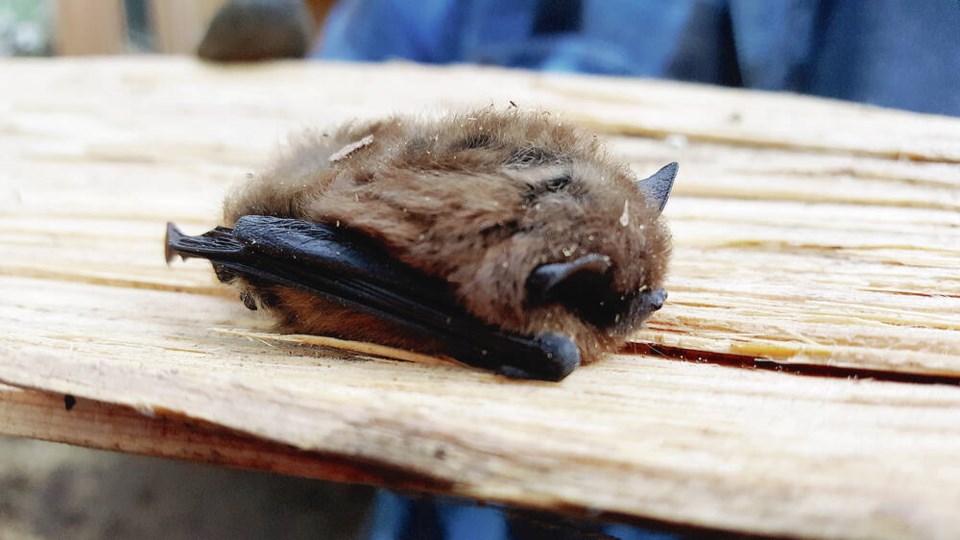A deadly fungus that has killed more than six million bats in eastern North America is probably in B.C. but has not been detected yet, says a B.C. biologist and bat specialist.
Bats infected with the rapidly spreading disease, called white nose syndrome, develop a white fungus on their nose and wing membranes during hibernation. The condition kills the bats by forcing them to wake up from hibernation and use their energy to groom the fungus off their bodies.
The fungus was found in Alberta last year and has been in Washington state since 2016.
“There was an unconfirmed report of a bat who was probably infected with white nose syndrome (WNS) on Orcas Island in the U.S. That’s 10 kilometres from Victoria and that was already almost two years ago,” said Cori Lausen, director of the western bat conservation program run by Wildlife Conservation Society Canada.
The province is asking the public for help in detecting and preventing spread of the disease, by reporting any winter bat activity or sick or dead bats to the B.C. Community Bat Program at bcbats.ca.
Bats infected with WNS may fly in daylight in winter to find water or food and die from lack of energy in winter or early spring. WNS can be devastating to affected bat colonies. Mortality death rates in some cases are 80 to 100 per cent.
In 2014, little brown and northern bats species were emergency listed under the federal Species at Risk Act due to their population declines in eastern North America.
Although scientists expected the disease to spread quickly across the west, that hasn’t happened, said Lausen.
It’s tricky to test for the disease because biologists don’t know where the bats hibernate, she said.
Western bats are not like eastern bats, who huddle closely together in caves to survive the cold. Western bats don’t use caves and they can roost in trees on rocky slopes.
“We’re not going to see a mass die-off of our bats, everywhere,” said Lausen. “What we’re going to be looking at, what we’re already looking at in Washington, is this very slow, patchy decline of bats and it’s happening slowly because our bats don’t make giant, long distance flights like they do in the east.”
Scientists are concerned that because it’s spreading so slowly, people might think WNS won’t affect our bats, said Lausen.
“Right now, we have no indication it’s going to be any different than the east. It might be another decade before we finally see the collapse of these bats, versus within a few years, like it was in the east.”
But bats in some parts of B.C. may benefit from shorter, milder winters. Lausen has found in her research that western bats spend less time in hibernation than eastern bats and they go into winter with more fat than they need.
“They might have WNS and they might not die from it if they have enough fat to burn fighting off the fungus,” she said.
Since 2019, Lausen has been studying whether probiotics will help prevent the disease. She and her team have been spraying probiotics at maternity roosts in Greater Vancouver and have expanded the project to Washington state because the disease has not been detected here yet.
The research is promising but it’s slow, she said.
In the few colonies that have the disease in Washington, researchers are finding dead bats in spring. If infected bats manage to make it through the winter, the fungus may have eaten big holes in their wings or they may be very scarred.
Last summer, the province began sampling guano, or bat dung, under bridges to see if they could detect the fungus, said Lausen. “It’s just a matter of time and our time has almost run out, I would say.”
Bats are needed in all of our ecosystems and our economies, said Lausen.
“Most people don’t realize they are little flying grizzly bears. They live up to 40 years and they reproduce slowly. … It’s going to be hard to replace those populations. When they’re gone, it could be hundreds of years for those populations to bounce back.”
Anyone who finds a dead bat or sees winter bat activity is asked to report it to the B.C. Community Bat Program at bcbats.ca, via email at [email protected] or by calling 1-855-922-2287.
Bat experts say all live bats should be left alone — keep your distance, snap a photo and report it to the B.C. Community Bat Program. If you must move a bat, visit bcbats.ca for advice and never touch a bat with your bare hands. Anyone, including pets, who comes into direct contact with a bat is advised to seek further information regarding the risk of rabies.
>>> To comment on this article, write a letter to the editor: [email protected]



